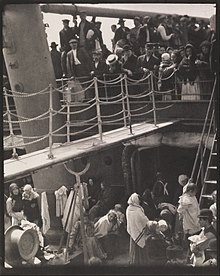Steerage is a term for the lowest category of passenger accommodation in a ship. In the nineteenth and early twentieth century, considerable numbers of persons travelled from their homeland to seek a new life elsewhere, in many cases North America and Australia. Many of those people were destitute in their homeland and had the minimum of resources to procure transportation. The term later widened to imply the lowest category of accommodation on a passenger vessel.

Steerage class travel edit
Steerage refers to the lowest possible category of long-distance steamer travel. It was available to very poor people, usually emigrants seeking a new life in the New World, chiefly North America and Australia. In many cases, these people had no financial resources and were attempting to escape destitution at home. Consequently, they needed transportation at an absolute minimum cost. In many cases they provided their own bedding and food. Steerage was very cramped and there was hardly any room for fresh air to get there. Many people died in steerage.
The term steerage was used to refer to the lowest category of accommodation, usually not including proper sleeping accommodation. In the United Kingdom, it was often referred to as third class, but there were instances where steerage was effectively fourth-class. In time, the designation came to refer to the lowest category in general, and in modern times is sometimes used sarcastically to refer to any uncomfortable accommodation in an airliner, ship or train.[1][2]
Beds were often long rows of large shared bunks with straw mattresses and no bed linens.[3]
A commentator described conditions in steerage aboard the SS Kaiser Wilhelm II in 1906:
900 steerage passengers [are] crowded into the hold of ... the Kaiser Wilhelm II, of the North German Lloyd line[. They] are positively packed like cattle, making a walk on deck when the weather is good, absolutely impossible, while to breathe clean air below in rough weather, when the hatches are down is an equal impossibility. The stenches become unbearable... [and the] division between the sexes is not carefully looked after, and the young women who are quartered among the married passengers have neither the privacy to which they are entitled nor are they much more protected than if they were living promiscuously. The food, which is miserable, is dealt out of huge kettles into the dinner pails provided by the steamship company.[4]
References edit
- ^ Collins English Dictionary and Thesaurus, HarperCOllins Publishers, Glasgow, 1993, reprinted 2010, ISBN 978 0 00 780782 6
- ^ Gjenvick, Paul K. "Steerage Class - Immigrant's Journey | GG Archives". www.GGArchives.com. Retrieved 2017-04-05.
- ^ Solem, Børge. "Steerage Passengers - Emigrants Between Decks". www.norwayheritage.com. Retrieved 2017-04-05.
- ^ Steiner, Edward A. (1906). "The Fellowship of the Steerage". On the Trail of The Immigrant. New York: Fleming H. Revell Company. pp. 35–38. OCLC 1111830971. OL 7055344M.
External links edit
- "Steerage - Immigrant Journeys to Their New Home", GG Archives
- "Steerage Class - The Immigrant Journey: The Fellowship of the Steerage (1905)", GG Archives
- "Steerage Passenger Lists". GG Archives. – Special Collection of Rare Steerage Souvenir Passenger Lists produced by the German Steamship Lines Hamburg-Amerika and Norddeutscher Lloyd.